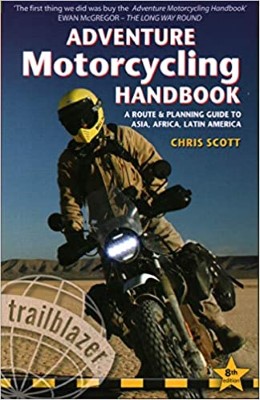 16Likes 16Likes
 |

7 Apr 2016
|
|
Registered Users
New on the HUBB
|
|
Join Date: Apr 2015
Location: Brisbane
Posts: 15
|
|
|
Recovering a drowned GSA1200 (2016 model)
Hello fellow BMW riders,
I am planning a trip from Brisbane to Tasmania (Australia) and there are a few creek crossings for me along the way.
Thinking about the worst and should I happen to go down in a water crossing and believe that water has passed into the air intakes and/or exhaust, then how do I recover the bike before starting it?
I know I would have to remove the spark plugs somehow but is there anything else I should do? What about removing the exhaust? Or is water that accumulated in there going to be blown out?
Would most of you take a few litres of oil because if there is water in the oil then we would have to drain and replace the whole lot right?. How does one achieve this?
Also - not related to the above but on a long journey are you carrying tire irons and tubes with you or just a tire plug kit. Tubes and tire levers add a fair bit of weight and I would have to say that most people I've spoken to get away with just using a tire plug kit so chances of using it would be perhaps 2%.
Thank you in advance
Ben
|

7 Apr 2016
|
|
Registered Users
Veteran HUBBer
|
|
Join Date: May 2014
Location: East Yorkshireman...in the Chum Phae area, Thailand
Posts: 1,359
|
|
|
I have tubed tyres anyway and I always carry tyre irons and tubes on trips, I even took them to use on my rental bike in Thailand. They are only light weight and fortunately I have not used them yet
Wayne
|

7 Apr 2016
|
|
Registered Users
New on the HUBB
|
|
Join Date: Apr 2015
Location: Brisbane
Posts: 15
|
|
|
G'day Lonerider
Thanks for your response.
Were you travelling on a GS1200? and if so what type of tubes did you carry with you?
Would you not recommend taking a patch of tube say 4 by 4 inches, glueing it to the area required from the inside to save weight?
Ben
|

8 Apr 2016
|
|
Registered Users
Veteran HUBBer
|
|
Join Date: May 2014
Location: East Yorkshireman...in the Chum Phae area, Thailand
Posts: 1,359
|
|
Quote:
Originally Posted by benok

G'day Lonerider
Thanks for your response.
Were you travelling on a GS1200? and if so what type of tubes did you carry with you?
Would you not recommend taking a patch of tube say 4 by 4 inches, glueing it to the area required from the inside to save weight?
Ben
|
Hi Ben
My bike is a XT600e and the hire bike was a CRF250L. I prefer to carry tubes for both front and rear, both heavy duty
Never even thought of that, but think I would still prefer tubes
Wayne
|

7 Apr 2016
|
 |
R.I.P.
Veteran HUBBer
|
|
Join Date: Aug 2003
Location: california
Posts: 3,824
|
|
Quote:
Originally Posted by benok

Hello fellow BMW riders,
I am planning a trip from Brisbane to Tasmania (Australia) and there are a few creek crossings for me along the way.
Thinking about the worst and should I happen to go down in a water crossing and believe that water has passed into the air intakes and/or exhaust, then how do I recover the bike before starting it?
I know I would have to remove the spark plugs somehow but is there anything else I should do? What about removing the exhaust? Or is water that accumulated in there going to be blown out?
Would most of you take a few litres of oil because if there is water in the oil then we would have to drain and replace the whole lot right?. How does one achieve this?
Also - not related to the above but on a long journey are you carrying tire irons and tubes with you or just a tire plug kit. Tubes and tire levers add a fair bit of weight and I would have to say that most people I've spoken to get away with just using a tire plug kit so chances of using it would be perhaps 2%.
Thank you in advance
Ben
|
Are you riding ALONE? Perhaps a buddy running tubes can carry tire irons. But I would ALWAYS carry tubes in case of side wall slice or big hole too big to plug.
The first thing to remember with a drowned bike is:
1. Shut off engine ASAP after you fall. A running engine will SUCK in water fast.
2. Get the bike UPRIGHT immediately. Once it's UP again you can rest and get help to get her across to dry land.
3. Once on dry land, pull plugs, lean bike over on each side, open air box, drain water out by laying on it's side. With help, stand bike UP on back wheel to allow exhaust pipes to drain.
If you do all this quickly, chances are good oil will be OK, and even if it turns baby poop brown, you can run it quite a distance without damage if not TOO diluted with water. But if it's badly diluted ... change it ASAP. NO ... I would not carry extra oil. Main thing is ... DON'T fall off into water! 
This is all different if bike is totally submerged with engine running. NOT GOOD.
Also, if it's Salt water ... much more serious problems exist.
But ... if minor, then ...Once all water has been drained best you can (as described above), dry out air filters best you can if wet. Leave plugs out while drying.
Once dry and all water drained, with plugs OUT and filters OUT, crank engine over to expel any left over water. Hold throttle WIDE OPEN during this part. Run starter in 5 second intervals, waiting 30 sec. in between cranking.
Once all water is expelled, filters fairly dry, re-install plugs, blowing out plug connectors, re-install air filters and air box covers. Fire her up. After 5 minutes, check color of oil. It may be discolored ... baby poop brown ... if not too bad, ride on and change at first opportunity.
Pick your line carefully and watch buddies who go before you. Be aggressive, but no need to ride super fast, just be smooth and steady on power. Look way ahead of where you want to go ... and don't "Death Grip" the bars.
Never hesitate once you start.

|

7 Apr 2016
|
|
Registered Users
New on the HUBB
|
|
Join Date: Apr 2015
Location: Brisbane
Posts: 15
|
|
|
Mollydog,
Thanks very much for the reply. That was a really good response and I'll take that piece of advice with me on the ride.
Now I just have to figure out how to get the air filter out and spark plugs etc.
Would you not just carry a patch of tube to put over the torn side wall rather than putting a whole tube inside the tire? Maybe even a patch on top of another patch then the air inside the tire could hold it in place. What do you think of that?
Thanks for responding
|

8 Apr 2016
|
 |
Super Moderator
Veteran HUBBer
|
|
Join Date: Dec 2004
Location: London and Granada Altiplano
Posts: 3,165
|
|
 R1200GSA with tubeless TKC80s
R1200GSA with tubeless TKC80s
After 250,000 miles on various BMWs with TKC80 tubeless tyres without a puncture I was bored one day and seeing as the back tyre needed changing I used an electric drill to puncture the tyre so I could test my skills with my virgin unused tubeless repair kit. At which stage I found it was a POS.
So if I'm riding a tubeless-equipped bike I now carry a 'Stop 'n Go' tyre plugger plus electric pump.
I never carried a spare tube or tyre levers/irons on a tubeless setup. My preference nowadays is for mousses—don't need to carry anything at all.
__________________
"For sheer delight there is nothing like altitude; it gives one the thrill of adventure
and enlarges the world in which you live," Irving Mather (1892-1966)
|

10 Apr 2016
|
|
Registered Users
Veteran HUBBer
|
|
Join Date: Dec 2007
Location: South of the border (MN)
Posts: 171
|
|
Quote:
Originally Posted by Tim Cullis

After 250,000 miles on various BMWs with TKC80 tubeless tyres without a puncture... So if I'm riding a tubeless-equipped bike I now carry a 'Stop 'n Go' tyre plugger plus electric pump. |
I have several times over 250k miles on various motos, including BMW tubeless. I get flats all too often and I'm good at fixing them on the side of the road. If you carry a SnG kit, do also carry the gold gummy worm style plugs plus a plug insertion tool. I found the SnG plugs did not seal on several occasions, and on the advice of a small moto shop here, made the switch to the gold gummy worm plugs. When you ream out the hole and then insert the plug, make a twist with your insertion tool to form a "knot" in the end of the plug to hold it in place inside the tire. Not bashing SnG or TC, but my experience with SnG is such that I won't depend on it.
|

10 Apr 2016
|
 |
R.I.P.
Veteran HUBBer
|
|
Join Date: Aug 2003
Location: california
Posts: 3,824
|
|
Quote:
Originally Posted by LD Hack

I have several times over 250k miles on various motos, including BMW tubeless. I get flats all too often and I'm good at fixing them on the side of the road. If you carry a SnG kit, do also carry the gold gummy worm style plugs plus a plug insertion tool. I found the SnG plugs did not seal on several occasions, and on the advice of a small moto shop here, made the switch to the gold gummy worm plugs. When you ream out the hole and then insert the plug, make a twist with your insertion tool to form a "knot" in the end of the plug to hold it in place inside the tire. Not bashing SnG or TC, but my experience with SnG is such that I won't depend on it.
|
Plus One on negative experience with Stop & Go plugs. Maybe LD and I are doing something wrong? But I've tried to fix two moderate holes with the Stop & Go ... and both failed! 
I've never had such issues using the sticky worm plugs ... done many repairs ... mostly for friends and even strangers. All good. I have the Stop & Go kit but will GIVE IT AWAY to the guy who buys my Tiger 1050! I can't use it.
There is some technique in installing the worm. Use LOTS of glue, double it up going in, twist and pull tool back out and this should UN-HOOK the worm from the insert tool, leaving worm securely in the hole.
If in doubt, practice doing this on an old tire off the bike. Bring
extra tubes of rubber cement. (not big ones as they'll get punctured and make a mess). Lots of small tubes best. (or a big jar maybe?)

|

23 Jul 2017
|
|
Registered Users
Veteran HUBBer
|
|
Join Date: Aug 2015
Posts: 489
|
|
Quote:
Originally Posted by Tim Cullis

My preference nowadays is for mousses—don't need to carry anything at all.
|
yeah, mousses would be nice if only they were indestructible. Unfortunately they're not, they can overheat and get damaged so still carrying a tubes and strong zip ties is essential for longer rides in remote areas. Also, mousse are still freaking expensive for what it is.
|

8 Apr 2016
|
 |
R.I.P.
Veteran HUBBer
|
|
Join Date: Aug 2003
Location: california
Posts: 3,824
|
|
Quote:
Originally Posted by benok

Mollydog,
Thanks very much for the reply. That was a really good response and I'll take that piece of advice with me on the ride.
Now I just have to figure out how to get the air filter out and spark plugs etc.
Would you not just carry a patch of tube to put over the torn side wall rather than putting a whole tube inside the tire? Maybe even a patch on top of another patch then the air inside the tire could hold it in place. What do you think of that?
Thanks for responding
|
No way to effectively patch a sidewall ... especially on the side of the road. It will never hold. Even a big hole can be hard to put a plug in or patch.
A tire shop MIGHT be able to fix the tire ... but when traveling ... a tube in the tire is your best option. Its what we do. It works.
Be SURE to check and clean inside tire for sharp debris before installing your new tube. Often times bits of nail, screws or staples are hiding in the tire. You won't see it ... but can FEEL it with your hand. (Use caution)
I would go over your owners manual to learn how to remove plugs and air filter and such.
Go to owners forums to get other experiences on drowned out GS's and how the owners handle it. Many do the WRONG THING ... and RUIN their engine ...
HydroLoc is always a danger if engine fills up with water ... and then crank it over. (It will bend a rod ... RUINED!)
Guys also ride with too much water in the oil .... and never even know it ...
once again ... RUINED ENGINE.
If crossing really deep water, have friends standing by to help or let a more experienced rider take the bike across the water. I rode a friends R1200GS out of a very tough area in Mexico's Copper Canyon. He had fallen 5 times ... and finally was exhausted. He rode my Vstrom out ... which he found much easier.
Practice at home taking things apart, doing basic services: Oil and filter change, Air filter change, Spark Plug change. Practice also removing wheels from bike, learn where all the spacers and bits and pieces go.

|

8 Apr 2016
|
|
Registered Users
Veteran HUBBer
|
|
Join Date: Apr 2005
Location: Oxford UK
Posts: 2,120
|
|
Quote:
Originally Posted by mollydog

No way to effectively patch a sidewall ... especially on the side of the road. It will never hold. Even a big hole can be hard to put a plug in or patch.
... a tube in the tire is your best option. Its what we do. It works.
Be SURE to check and clean inside tire for sharp debris before installing your new tube. Often times bits of nail, screws or staples are hiding in the tire. You won't see it ... but can FEEL it with your hand. (Use caution)
|
Never had to do it myself - even in my wing, prayer and no money early biking days, but I have seen African bus drivers stitching rips in tyre sidewalls with a large "needle" (looked something like an awl) and string.
The idea was to hold the two sides together so the tube wouldn't bulge out of the gap when it was inflated. I've no idea how far you'd get like that but one bus was in the desert at least 50 miles from the nearest town so it had better have worked.
Agreed about checking the inside of the tyre for sharp bits. It doesn't take much to put (another) hole in the tube. It's best done with your bare fingertips - but very carefully. If there is something sticking out it'll rip your fingers as easily as the tube. 
|

8 Apr 2016
|
|
Registered Users
New on the HUBB
|
|
Join Date: Apr 2015
Location: Brisbane
Posts: 15
|
|
Thanks mate.


|

10 Apr 2016
|
 |
R.I.P.
Veteran HUBBer
|
|
Join Date: Aug 2003
Location: california
Posts: 3,824
|
|
Quote:
Originally Posted by backofbeyond

Never had to do it myself - even in my wing, prayer and no money early biking days, but I have seen African bus drivers stitching rips in tyre sidewalls with a large "needle" (looked something like an awl) and string.
The idea was to hold the two sides together so the tube wouldn't bulge out of the gap when it was inflated. I've no idea how far you'd get like that but one bus was in the desert at least 50 miles from the nearest town so it had better have worked.
Agreed about checking the inside of the tyre for sharp bits. It doesn't take much to put (another) hole in the tube. It's best done with your bare fingertips - but very carefully. If there is something sticking out it'll rip your fingers as easily as the tube.  |
I've seen the Mexicans patch in similar way with big side wall rips. They stitch and then VULCANIZE it, setting the whole mess on fire! Really toxic but damn if it doesn't work. I saw this on a truck tire. (expensive). A friend on a Baja ride had his side wall repaired in a similar way, I never saw it, just heard about it later. He made another 1000 miles of tough terrain. If the tube BULGES out, it's likely to get popped at some point. HD tubes stays in the tire better. Soft tube, not so much. The Mexican Llanteros are absolute wizards at this sort of improvisation ... but it's a dying art as nearly everything, everywhere there is now paved over (not good for riders!).
|
|
Currently Active Users Viewing This Thread: 1 (0 Registered Users and/or Members and 1 guests)
|
|
|
 Posting Rules
Posting Rules
|
You may not post new threads
You may not post replies
You may not post attachments
You may not edit your posts
HTML code is Off
|
|
|
|

Check the RAW segments; Grant, your HU host is on every month!
Episodes below to listen to while you, err, pretend to do something or other...

2020 Edition of Chris Scott's Adventure Motorcycling Handbook.
"Ultimate global guide for red-blooded bikers planning overseas exploration. Covers choice & preparation of best bike, shipping overseas, baggage design, riding techniques, travel health, visas, documentation, safety and useful addresses." Recommended. (Grant)

Led by special operations veterans, Stanford Medicine affiliated physicians, paramedics and other travel experts, Ripcord is perfect for adventure seekers, climbers, skiers, sports enthusiasts, hunters, international travelers, humanitarian efforts, expeditions and more.
Ripcord Rescue Travel Insurance™ combines into a single integrated program the best evacuation and rescue with the premier travel insurance coverages designed for adventurers and travel is covered on motorcycles of all sizes.
(ONLY US RESIDENTS and currently has a limit of 60 days.)
Ripcord Evacuation Insurance is available for ALL nationalities.
What others say about HU...
"This site is the BIBLE for international bike travelers." Greg, Australia
"Thank you! The web site, The travels, The insight, The inspiration, Everything, just thanks." Colin, UK
"My friend and I are planning a trip from Singapore to England... We found (the HU) site invaluable as an aid to planning and have based a lot of our purchases (bikes, riding gear, etc.) on what we have learned from this site." Phil, Australia
"I for one always had an adventurous spirit, but you and Susan lit the fire for my trip and I'll be forever grateful for what you two do to inspire others to just do it." Brent, USA
"Your website is a mecca of valuable information and the (video) series is informative, entertaining, and inspiring!" Jennifer, Canada
"Your worldwide organisation and events are the Go To places to for all serious touring and aspiring touring bikers." Trevor, South Africa
"This is the answer to all my questions." Haydn, Australia
"Keep going the excellent work you are doing for Horizons Unlimited - I love it!" Thomas, Germany
Lots more comments here!

Every book a diary
Every chapter a day
Every day a journey
Refreshingly honest and compelling tales: the hights and lows of a life on the road. Solo, unsupported, budget journeys of discovery.
Authentic, engaging and evocative travel memoirs, overland, around the world and through life.
All 8 books available from the author or as eBooks and audio books
Back Road Map Books and Backroad GPS Maps for all of Canada - a must have!
New to Horizons Unlimited?
New to motorcycle travelling? New to the HU site? Confused? Too many options? It's really very simple - just 4 easy steps!
Horizons Unlimited was founded in 1997 by Grant and Susan Johnson following their journey around the world on a BMW R80G/S.
 Read more about Grant & Susan's story
Read more about Grant & Susan's story
Membership - help keep us going!
Horizons Unlimited is not a big multi-national company, just two people who love motorcycle travel and have grown what started as a hobby in 1997 into a full time job (usually 8-10 hours per day and 7 days a week) and a labour of love. To keep it going and a roof over our heads, we run events all over the world with the help of volunteers; we sell inspirational and informative DVDs; we have a few selected advertisers; and we make a small amount from memberships.
You don't have to be a Member to come to an HU meeting, access the website, or ask questions on the HUBB. What you get for your membership contribution is our sincere gratitude, good karma and knowing that you're helping to keep the motorcycle travel dream alive. Contributing Members and Gold Members do get additional features on the HUBB. Here's a list of all the Member benefits on the HUBB.
|
|
|